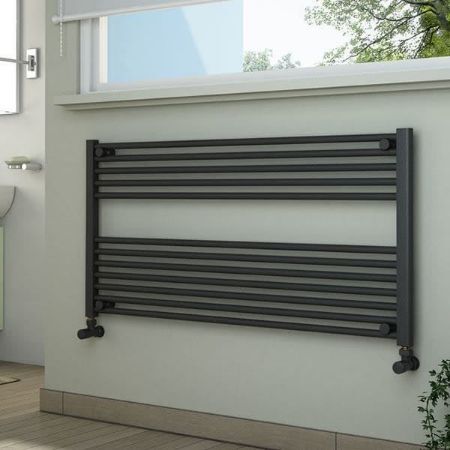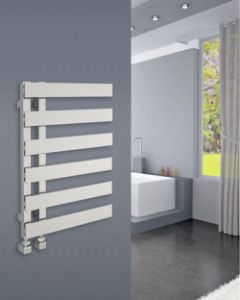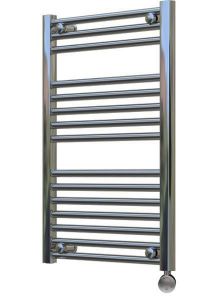Heated Towel Rails & Towel Radiators
Discover our extensive range of Towel Radiators that are designed to provide both functionality and style to your bathroom. We offer a wide selection of high-quality towel radiators in various styles, finishes, and niche sizes, ensuring that you can find the perfect fit for your bathroom decor. Browse and shop through our primary categories listed below to add a touch of sophistication to your bathroom while enjoying the practical benefits of a heated towel rail....
Choosing the right bathroom radiator or heated towel rail is simply a matter of browsing the categories in our online store according to your budget and requirements in terms of heat, space and design. We also stock a fantastic range of radiator valves, heating elements and radiator accessories engineered to assist you at every stage of the installation process and to supply the finishing touches to your setup. For a more detailed information, please view our 5 Steps Guidance on buying a towel radiator blog post.
Tip: If your towel rail is £140, why not add a pair of valves to qualify for Free Delivery?
Another factor that can influence the cost of bathroom towel radiator delivery is the delivery address. There are surcharges to Scottish Islands & Highlands, Northern Ireland, Channel Islands, Isle of Man, Isle of Wight etc. Once you added all products to your basket, you can use our “Estimate Delivery” link to work out total delivery fee which will take your location and product weights & sizes into consideration. Alternatively, you can visit our Delivery & Returns page for more information on cost and delivery services we offer.
Furthermore, the delivery service chosen can impact the price. We offer different delivery options such as standard delivery, express delivery, or even next-day delivery. Each of these options may come with varying costs, with faster delivery methods generally being more expensive. It is important to consider the urgency of the delivery and weigh it against the additional cost to determine the most suitable delivery method for your heated towel rails & parts.
Choosing the right style of heated towel rail is very important, so you need to give a lot of thought to what type of decorative finish you desire. Contemporary bathrooms will benefit from a sleek, modern designer towel radiators whereas a Victoriana-style heated towel rail would be suitable for a bathroom with a more traditional finish. You don’t even have to stick with a chrome finish as there are other colour and finish options available. Size is also an important consideration. Larger bathrooms will be able to cope with a large towel rail, but if your small room is exceedingly compact, a small heated towel rail will be a much better choice.
Secondly, even though they are both same size in overall width and height, they may not necessarily have the same surface space. While one has 15 number of horizontal bars with larger and bigger main gaps, other one could have a total of 24 horizontal bars with smaller main gaps. Naturally the bathroom radiator with more bars will have more surface space and as a result, it will give more heat compared the other one with less bars. Diameter of these bars, thickness of the steel used, amount of plating or paint, quality of the raw material used are all other factors which may contribute to higher or lower heat outputs of a radiator. Like most things, heavier the radiator means more bars, more surface space and more heat.
Designer models on the other hand almost always have metal brackets. These are located at a set point on all 4 corners and welded at the back of the vertical tubes. As the bracket locations are set and cannot be moved or changed, installing designer towel radiator brackets is trickier compared to standard towel rails. With these fixed point brackets, installers must take precise measurements before drilling holes for the raw plugs. As always, measure twice (even three times) but drill once to avoid misaligned radiators on the wall.
How To Choose The Right Towel Radiator?
When it comes to the practical setup of your main bathroom or an en suite, a towel rail proves an exceptionally useful addition because it will regulate your bathroom temperature and environment while providing efficient storage space for your towels and other garments. This is vital in bathrooms that do not enjoy the benefit of large dimensions and ample space.Choosing the right bathroom radiator or heated towel rail is simply a matter of browsing the categories in our online store according to your budget and requirements in terms of heat, space and design. We also stock a fantastic range of radiator valves, heating elements and radiator accessories engineered to assist you at every stage of the installation process and to supply the finishing touches to your setup. For a more detailed information, please view our 5 Steps Guidance on buying a towel radiator blog post.
How Much Is A Towel Radiator Delivery?
The cost of delivering a towel radiator can vary depending on several factors. Firstly, weight and size of the radiator itself will play a significant role in determining the delivery charges. If your chosen towel rail is 1200mm or more on the longest side, a large item surcharge will apply regardless of your order total or delivery location. We can group heated towel rails by size to 3 groups below;- Group 1 – Those with the longest side less than 1200mm: £0.00 to £11.95 depending on your order total
- Group 2 – Those with the longest side between 1200mm to 1500mm: minimum £5.95
- Group 3 – Those with the longest side more than 1500mm: minimum £11.95
Tip: If your towel rail is £140, why not add a pair of valves to qualify for Free Delivery?
Another factor that can influence the cost of bathroom towel radiator delivery is the delivery address. There are surcharges to Scottish Islands & Highlands, Northern Ireland, Channel Islands, Isle of Man, Isle of Wight etc. Once you added all products to your basket, you can use our “Estimate Delivery” link to work out total delivery fee which will take your location and product weights & sizes into consideration. Alternatively, you can visit our Delivery & Returns page for more information on cost and delivery services we offer.
Furthermore, the delivery service chosen can impact the price. We offer different delivery options such as standard delivery, express delivery, or even next-day delivery. Each of these options may come with varying costs, with faster delivery methods generally being more expensive. It is important to consider the urgency of the delivery and weigh it against the additional cost to determine the most suitable delivery method for your heated towel rails & parts.
High BTU Heat Output Heated Towel Rails
Some form of heat is essential for a bathroom and without any heat, showers and baths will be most unpleasant. Old-fashioned radiators do an OK job, but if you want your bathroom or en suite to look modern and stylish, a heated towel rail is a far better choice. The main problem with old-fashioned radiators is that they are not much good at drying multiple towels. A heated towel rail, on the other hand, is perfectly designed for drying and warming towels. The innovative ladder design of heated towel rails dries towels far more efficiently than a regular radiator, so your towels will be nice and dry within a short time.Choosing the right style of heated towel rail is very important, so you need to give a lot of thought to what type of decorative finish you desire. Contemporary bathrooms will benefit from a sleek, modern designer towel radiators whereas a Victoriana-style heated towel rail would be suitable for a bathroom with a more traditional finish. You don’t even have to stick with a chrome finish as there are other colour and finish options available. Size is also an important consideration. Larger bathrooms will be able to cope with a large towel rail, but if your small room is exceedingly compact, a small heated towel rail will be a much better choice.
Can Two Same Size Bathroom Radiators Have Different Heat Outputs?
Heat output of a radiator is all about its size and actual surface space as well as the temperature of the water inside. Say you have two same sized bathroom towel radiators from two different suppliers. They are both 500mm wide and 1200mm high but somehow they have different BTU figures! In this case the first thing you will need to check would be the Detla T figure used for calculation to ensure if they are both using the same. While Delta 50 (Δ T50) is now the UK standard, some sellers do advertise their radiators at Delta 60 (Δ T60). As an example; if a bathroom towel radiator is tested, approved and declared as 1,000BTU using Delta 50, it can be advertised and sold as giving out 1,000BTU. But it can also be advertised as 1264BTU based on Delta 60. This gives an illusion of getting more heat to a novice buyer. You can find more information on Delta T and differences between Delta 50 and Delta 60 on our blog post.Secondly, even though they are both same size in overall width and height, they may not necessarily have the same surface space. While one has 15 number of horizontal bars with larger and bigger main gaps, other one could have a total of 24 horizontal bars with smaller main gaps. Naturally the bathroom radiator with more bars will have more surface space and as a result, it will give more heat compared the other one with less bars. Diameter of these bars, thickness of the steel used, amount of plating or paint, quality of the raw material used are all other factors which may contribute to higher or lower heat outputs of a radiator. Like most things, heavier the radiator means more bars, more surface space and more heat.
How to Remove a Towel Radiator for Decorating Purposes?
Radiators can be a pain when the time comes to redecorate a room. Painting behind the towel radiator is not too difficult, but if the wall has been papered and you want to remove the old paper to either paint or repaper, the radiator is likely to be very much in the way. Most towel radiators have simple and easy to remove wall fixing brackets. Removing these will make your life a lot easier and if you are reasonably skilled on the DIY front, there is no reason why you shouldn’t be able to do the job yourself. You can find more information using our blog post on how to remove a towel radiator.The Dos and Don'ts of Adding an En Suite Bathroom
Adding an en suite to the master bedroom can increase your property value, but only if the job is done properly. So what are the dos and don'ts of building an en suite and what pitfalls should you try and avoid?- Do plan the space carefully.
- Do ensure there is adequate ventilation.
- Don't sacrifice a bedroom.
- Don't use dark colours.
- Do ensure there is adequate heating by installing a heated towel rail.
Can a Wet Room Add Value to Your Home?
Wet rooms are becoming increasingly popular in modern UK homes, although they have been common on the continent for many years. The beauty of a wet room is that it is uncluttered and streamlined, which for many people is their idea of a perfect bathroom. But although you may love the idea of replacing your Victoriana bathroom with an ultra stylish wet room, will it add value or would you be better spending your money on a traditional bathroom radiator instead?Are Towel Radiator Mounting Brackets Metal or Plastic?
This will depend on the model you select but most ladder type towel rails have plastic and most designer models have metal brackets. In both cases brackets will match the radiator finish for a complete and nicer look. With standard ladder towel rails, brackets are affixed between any of the two horizontal bars. This makes it easier to install as there is great deal of flexibility on its location. For a stronger support to hang towel rails on the wall, they are usually placed between the 2nd and 3rd bars from the top, as well as the bottom. Unlike some other suppliers, all our towel rails come with a set of 4 brackets instead of 3. It is best to install these brackets as close as possible to the side vertical tubes so that you can have larger space in the middle to hang your towels.Designer models on the other hand almost always have metal brackets. These are located at a set point on all 4 corners and welded at the back of the vertical tubes. As the bracket locations are set and cannot be moved or changed, installing designer towel radiator brackets is trickier compared to standard towel rails. With these fixed point brackets, installers must take precise measurements before drilling holes for the raw plugs. As always, measure twice (even three times) but drill once to avoid misaligned radiators on the wall.
We are committed to offering quality radiators at low prices and we aim to deliver an outstanding level of service for each and every customer.
Read moreFeatured Products
Product Code: ELS-PF5075C
Availability
6 in stock500mm wide and 750mm high pre-filled chrome flat heated towel rail with 253 Watt - 864 BTU/h heat output @ Delta 50. Comes complete with 200 Watt standard type electric element.
£149.99 inc. VAT
Product Code: RND-ALC01
Availability
10 in stock495mm wide and 960mm high chrome plated traditional style built-in white column radiator with 650 Watt - 2215 BTU/h @ Delta 50.
£279.99 inc. VAT
Product Code: ADG8060C
Availability
18 in stock800mm wide and 600mm high chrome flat heated towel rail with 304 Watt - 1036 BTU/h @ Delta 50.
£159.99 inc. VAT
Product Code: EMR5080W
Availability
13 in stock500mm wide and 800mm high rectangular tubed white ladder style designer towel radiator with 347 Watt - 1183 BTU/h @ Delta 50.
£149.99 inc. VAT
Product Code: EMR5080A
Availability
25 in stock500mm wide and 800mm high rectangular tubed anthracite ladder style designer towel radiator with 347 Watt - 1183 BTU/h @ Delta 50.
£127.99 inc. VAT
£159.99 inc. VAT
£159.99 inc. VAT
Product Code: EMR5080C
Availability
28 in stock500mm wide and 800mm high rectangular tubed chrome plated ladder style designer towel radiator with 274 Watt - 934 BTU/h @ Delta 50.
£209.99 inc. VAT
Product Code: MK40/140
Availability
1 in stockKALYPSO Black Designer Bathroom Radiator - 440mm Wide 1400mm High
£199.99 inc. VAT
£219.99 inc. VAT
£219.99 inc. VAT
Product Code: RND-HNV17A
Availability
10 in stock1003mm wide and 550mm high ecliptic tubed horizontal design single anthracite coated radiator with 838 Watts - 2859 BTU/h @ Delta 50
£224.99 inc. VAT
Product Code: RND-HNV17
Availability
10 in stock1003mm wide and 550mm high ecliptic tubed horizontal design single white coated radiator with 838 Watts - 2859 BTU/h @ Delta 50
£224.99 inc. VAT
Product Code: RND-HNV20A
Availability
10 in stock1180mm wide and 550mm high ecliptic tubed horizontal design single anthracite coated radiator with 987 Watts / 3364 BTU @ Delta 50
£259.99 inc. VAT
Product Code: RND-HNV20D
Availability
10 in stock1180mm wide and 550mm high ecliptic tubed horizontal design double white coated radiator with 1973 Watts - 6728 BTU/h @ Delta 50
£364.99 inc. VAT
Product Code: RND-HNV24A
Availability
10 in stock1416 mm wide and 550mm high ecliptic tubed horizontal design single anthracite coated radiator with 1163 Watts / 3965 BTU @ Delta 50
£294.99 inc. VAT
Product Code: RND-HNV14D
Availability
2 in stock826mm wide and 550mm high ecliptic tubed horizontal design double white coated radiator with 1381 Watts - 4710 BTU/h @ Delta 50
£274.99 inc. VAT
Product Code: RND-HNV14
Availability
10 in stock826mm wide and 550mm high ecliptic tubed horizontal design single white coated radiator with 691 Watts - 2355 BTU/h @ Delta 50
£189.99 inc. VAT
Product Code: ELT-PF5075C
Availability
4 in stock500mm wide and 750mm high pre-filled chrome flat heated towel rail with 253 Watt - 864 BTU/h heat output @ Delta 50. Comes complete with a water temperature based 300 watt thermostatic electric heating element which you can regulate temperature.
£199.99 inc. VAT
Product Code: ADG8080C
Availability
5 in stock800mm wide and 800mm high chrome flat heated towel rail with 385Watt - 1313 BTU/h @ Delta 50.
£169.99 inc. VAT
Product Code: EMR5012W
Availability
9 in stock500mm wide and 1232mm high rectangular tubed white ladder style designer towel radiator with 525 Watt - 1790 BTU/h @ Delta 50.
£189.99 inc. VAT
Product Code: EMR5012A
Availability
24 in stock500mm wide and 1232mm high rectangular tubed anthracite ladder style designer towel radiator with 525 Watt - 1790 BTU/h @ Delta 50.
£199.99 inc. VAT
Product Code: EMR5012C
Availability
16 in stock500mm wide and 1232mm high rectangular tubed chrome plated ladder style designer towel radiator with 414 Watt - 1414 BTU/h @ Delta 50.
£289.99 inc. VAT
Product Code: RND-HNV10A
Availability
10 in stock590mm wide and 550mm high ecliptic tubed horizontal design single anthracite coated radiator with 493 Watts - 1682 BTU/h @ Delta 50
£144.99 inc. VAT





























